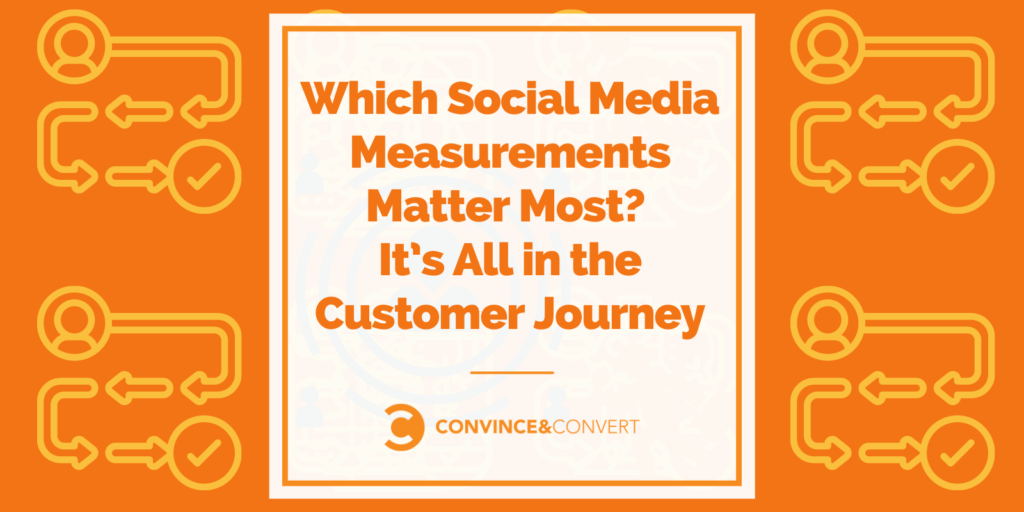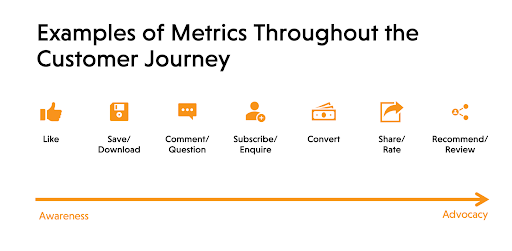
In today’s competitive social media landscapes, companies from mom and pop shops to large enterprises are struggling to attract audiences and engage with them in meaningful (read as: business goals-oriented) ways. Of course, a successful social media program now requires investment in ad dollars.
In fact, of marketers using paid tactics, 80% of B2C and 77% of B2B content marketers ran ads on social channels (Content Marketing Institute). However, certain channels and media (e.g. TikTok, Instagram Reels) do still allow for some content to break through in powerful, viral ways.
Barring those obvious viral hits though, how do brands know that their social media programs are meeting the mark and making an impact? To know that, social media teams must measure what matters most for each campaign, each channel, and/or each post.
How Audiences Engage with Social Media
I want you to take a minute and think about how you engage with brands on social media in your everyday life.
You may follow a couple of beloved brands to learn about upcoming product releases or to get pro tips. You may casually watch the videos that others’ make about products (I get an awful lot of “Target finds” and “Trader Joe’s finds” videos in my Instagram Reels). You may notice a post about a destination you’ve been thinking about (have you checked out our client Visit California’s TikTok lately?) and leave a comment asking for more information. You might tag a friend on an article that’s going to appeal to them.
For the most part, your interest in the content—and the ways in which you interact—will have to do with how familiar you are with the brand, as well as where you are along the customer purchase journey.
If you’re more invested in a brand (like me and Trader Joe’s), you may spend more energy engaging with their content to get information that’s valuable to you—you may even share those tips with someone else. If you’re less familiar with a brand, you may look—you may even like—but you probably won’t do more than that. Because of these behavioral differences, the social media measurements that matter to marketers will also change, depending on the role and goals of the content.
Which Social Media Metrics Matter Throughout the Customer Journey?
From the “Awareness” stage all the way through “Advocacy,” the types of interactions that customers will tend to engage in will vary in intent and veracity.
For instance, if we’re looking to understand audiences’ behaviors at the “Awareness” stage, we might measure likes or video through plays on social media posts aimed at this stage. Indeed, those actions indicate attention (albeit low-stakes).
At the “Consideration” stage, we might measure subscriptions to a newsletter or lead generation form-fills from social media posts aimed at this stage as most important (and ignore the number of likes, as it’s not relevant). For content aimed at customers post-purchase, we might be looking for the use of a community hashtag or comments on a story from a fellow customer.

How to Map Your Social Media to Metrics
Here’s the thing, there’s no one right approach to social media measurement. There is no one single approach to how brands use social media to connect with their audiences along their journeys. The key to all of them is to identify the goals of the social media content, so that you’re measuring for those behaviors.
Here are three common scenarios and how to organize:
If You Target Journey Stages with Specific Channels…
Let’s say your team is using social media channels to serve different audiences at different stages:
- LinkedIn for top-of-funnel awareness through thought leadership for enterprise customers
- YouTube for consideration through product comparisons and walk-throughs for small/medium business customers
- Twitter for servicing and customer retention for small/medium business customers
Since each channels each have different customer journey stages and different goals, the metrics would look something like this:
- LinkedIn: impressions, click-throughs, likes/comments, sales outreaches that mention social as a referral source
- YouTube: through-plays, comments, referrals
- Twitter: branded/non-branded mentions, interactions, percentage of customers serviced through Twitter
To track these metrics, your measurement dashboard would identify the goals per channel and report out the metrics based on those goals.
If You Target Journey Stages with Specific Campaigns…
Let’s say that, instead, your team plans and executes cross-channel campaigns that speak to specific audiences and journey stages. For each campaign, the metrics reported out would look different, for example:
- Awareness: impressions, likes, click-throughs
- Interest: video through-plays, comments, shares
- Consideration: video through-plays, comments, lead-gen form-fills, volume of social chatter/mentions
- Conversion: click-throughs to conversion landing pages, purchases from social referrals (website attribution), referral sources mentioning social media channels
- Advocacy: comments, volume of social chatter/mentions, branded hashtag usage, membership in dedicated social media groups
To capture the right metrics for each of these campaigns, you would tag the campaigns’ posts within your social media metrics tool with the audience and the journey stage. You would then pull together a picture of performance, using these metrics across the channels, for each audience throughout their journey.
If You Target Journey Stages with Individual Posts…
For many organizations, journey stages are addressed in a more ad hoc manner. Each individual social media post might vary in its target audience, its customer journey stage, and its goal. In this case, you’ll need to tag each post with its target audience and customer journey stage.
While the metrics will look similar to those in the previous example, the way in which we aggregate that data would be by audience, stage, and channel, so you’re able to compare apples to apples.
Final Notes
As you plan content, make sure you bake in the measurement framework. This will help your team to create content with clarity: design content whose goal is conversion to have strong CTAs; design content whose goal is top-of-mind awareness to focus on being saveable for reference.
Also, as you can see with the examples above, keep in mind that NOT all social media metrics are on-site behaviors. Social listening, self-reported referral sources while on-boarding, and website attribution/traffic sources are all important pieces of your social media measurements dashboard.
Finally, keep in mind that not all metrics are key performance indicators (KPIs)—the numbers that help to summarize the true success of your social media program in achieving your goals are the only ones that should be considered KPIs.
This content is adapted from one of my workshop sessions. If you’re interested in leveling up your social media practice through a customized workshop from me or the Convince & Convert team, reach out to us. You can also see me talk about tools, influencers, and social advertising at ContentTECH this May 31-June 2 (use code: HOU100 to save $100) and at Social Fresh this June 21-23.

